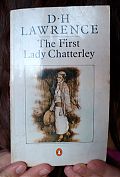
DH Lawrence
The First Lady Chatterley
It’s very rare to have a chance to read a published first draft of a novel, let alone a famous novel. DH Lawrence wrote Lady Chatterley’s Lover three times, the final draft being the one he published. After Lawrence’s death, the other two versions were revived by his wife Frieda. According to some and Frieda herself, the first draft titled The First Lady Chatterley is the best of the three. Of course this is a matter of opinion, mine being: the final draft is best.
The First Lady Chatterley seemed to have the workings of a great novel, but it is not a great novel in itself. It was enlightening to read what bits of words and phrases and ideas, made it from this draft to the final; and how Lawrence transfigured his characters and themes so that they became more clear. The most startling difference between the first and the final is the relative lack of sex. Instead of opposing Mellors’ tenderhearted fucking against cold industry and the horrors of war, we have the class struggle.
In The First Lady Chatterley, Mellors is not Mellors but Parkin. The similarities are slim: Parkin is working class till the end, his mannerisms are almost brutish. The isolation of the forest and the forest as nature are not important to Parkin. The forest is owned by the Chatterley’s, it’s where he works and he sometimes expresses enjoyment at catching poachers, and that’s about it.
In fact, nature complete is hardly visible in this first draft when compared to the final. In Lady Chatterley’s Lover, Nature is a living character necessary to Constance and Mellors. It is more than the lovers’ retreat, for it also provides boundaries between the couple and the world. The near lack of Lawrence’s fine nature descriptions is the second startling aspect of The First Lady Chatterley. Without it, the book feels rather empty, half-hearted.
Or maybe it felt empty because the relationship between Constance and Parkin is so different from that between Constance and Mellors. Without the intense attractions and repulsions, Constance and Parkin seem to fall into each other’s arms with a categorical aloofness that made me wonder about the sincerity of their emotions. Lady Chatterley’s Lover is perhaps a more fitting title to this version, as that’s all Constance seems to believe Parkin is. She hardly respects him, there’s little passion and they rarely talk; occasionally I thought she was just using him to get pregnant.
Lawrence has made Constance the “modern woman” he details in A Propos. Instead of opening herself completely—body and mind—as she does almost immediately for Mellors, finding beauty in his body for the sake of it, Constance only opens half-way.
There in the depths only the tenderness of the unknown can penetrate, and the warm gleam of the man, the male she loves. The deeps are dark, and in modern woman they are mostly closed up, closed up so completely and walled up so perfectly that their existence is unsuspected.
The major contention between Constance and Parkin is the class difference. Lawrence ingeniously eradicated this problem in the last draft by giving Mellors a high rank in the army and making him a well-read, intelligent man; he also gave Constance and Mellors more sexual experience before they met. By creating equality, Lawrence had more room to explore the themes he wanted to explore. But with Constance and Parkin, everything gets hung up on working class and gentry.
The relationship is impossible. A deeper connection is impossible. Parkin won’t live on Constance’s money and Constance won’t live in the working men’s hovels. Parkin gets political and starts mixing Communism with his desire for Lady Chatterley. Between the first draft and the third draft one gets something different completely. One almost believes Lawrence advanced to Lady Chatterley’s Lover by first envisioning its opposite.
If I also had the second draft of Lady Chatterley’s Lover, titled John Thomas and Lady Jane, sitting on my shelf, I would no doubt be reading it now. It has been difficult to let the book go; even after having learned that it has resided in me for years now. As I re-read Lady Chatterley’s Lover and all its subsidiaries, I realized that this was the most influential book I’ve ever read. And this iota of self-knowledge comforts me in a way I never thought possible.
· · · · · · · · · · · · · · · · · · · ·